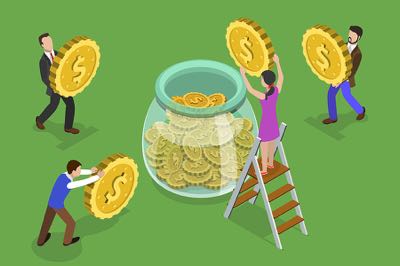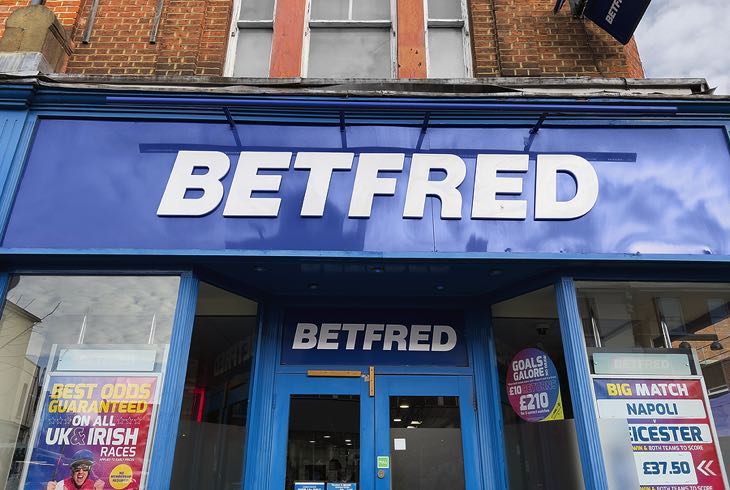 There are various sayings and adages that illustrate the fact that, in general, bookies make money and punters lose it. “You never see a bookie riding a bike” might be a little dated but it does the job nicely for us. If you prefer numbers to words, consider the fact that one bookmaker boss paid herself the highest salary in British history in 2019/20. Being more charitable, whilst also highlighting the same point, it is also worth noting that she has regularly been the largest tax-payer in the UK, as she and her family having a tax liability of £573m in the most recently published accounts.
There are various sayings and adages that illustrate the fact that, in general, bookies make money and punters lose it. “You never see a bookie riding a bike” might be a little dated but it does the job nicely for us. If you prefer numbers to words, consider the fact that one bookmaker boss paid herself the highest salary in British history in 2019/20. Being more charitable, whilst also highlighting the same point, it is also worth noting that she has regularly been the largest tax-payer in the UK, as she and her family having a tax liability of £573m in the most recently published accounts.
So, we know that bookmakers make money but how do they do it? Obviously, we know they accept wagers on sport and other events and most of the largest betting sites also offer online casinos, poker, bingo and other related games too. However, in this article, we focus specifically on the betting side of their businesses and, in particular, we will look at the mechanics of betting to demonstrate how a net win is created.
The Overround: Key to Bookie Success

Maddie Red Photography / Bigstockphoto.com
In the simplest sense, bookmakers make money from bets by offering odds that are lower than is fair. That sounds, well, unfair, but of course the bookie has to pay for staff, premises, technology, marketing and so on and, of course, they need to make a net win. Why bother taking the risk if they can’t make a net win? And, of course, this is the same way that all businesses operate really: they sell things for more than they cost. Is it unfair that a supermarket buys a loaf of bread for £1 and sells it for £1.20?
When it comes to betting, the bookie is not selling something in the same way but the principle is fundamentally the same. How this works in reality is best illustrated with an example, so let us consider a rare football match where the bookies think that the home win, the away win and the draw are all equally likely. Their research and analysis tell them that each outcome has the same likelihood of happening and so in effect if the game was hypothetically played three times (in exactly the same circumstances), there would be a draw and one win for each of the sides.
With a game like this, the fair odds would be 2/1 for each outcome because you could then back each outcome and break even no matter what happened. Whatever result occurred, you would lose two of your stakes but win one 2/1 bet to cover those. The concept of implied probability is key and this effectively turns betting odds into probability. It is calculated by dividing one by the decimal odds of any selection. So, for example, 2/1 is 3.0 in decimal odds and one divided by three is 0.33 (recurring), or simply 1/3, or one in three.
When a market is entirely “fair”, the bookie’s odds directly and completely reflect the true probabilities, or at least the perceived probabilities. In such a scenario, when we convert the odds into implied probabilities and then add together the probabilities for each selection, we will get 1, equating to 100%. So, with our very evenly poised football match, odds of 2/1 for each outcome mean we are adding 1/3 + 1/3 + 1/3 = 1.
However, as we have established, bookies do not offer “fair” odds, if we take fair to mean without any margin. So, if they believe a game of football has an equal chance of finishing with any of the three possible results, rather than offering 2/1 (3.0 in decimal) a betting site with very generous odds may offer 19/10 (2.9) for each on a highly competitive game, though probably much shorter for less competitive games/markets.
The Bookie’s Margin
Taking the odds of 2.9, this alters the implied probability from 33.33% (recurring), to 34.48%, altering the total of the probabilities to 103.44%. The book percentage in this market is, therefore, 103.44% and this is also the overround. Various terms are often used interchangeably and you may see the overround referred to as the vig, short for vigorish, or simply the bookie’s margin.
Though these terms may often be used by different people to mean the same thing, there are those who use them to mean subtly different, though related, things. Technically, the vig and the bookmaker’s margin refer to what percentage of the total stakes the bookmaker will win (all other things being equal).
So, for example, if we look at a bookie who accepts £100 on the home win at 2.9 and the same stake at the same odds on the other two possible outcomes, we can see how this maths plays out. The overround here is, as we have seen, 103.44%, though you may also see this stated as just 3.44% (i.e. the amount over the 100% that equates to a “fair” book). However, the bookmaker will receive £300 in stakes and pay back £290, thus making a net win of £10. This gives a slightly lower vigorish of 3.33%.
That may not seem like much given all the various overheads a bookmaker has. However, if we look at a more typical overround, one that is higher, created by odds that are lower, and consider a more reasonable sum for the total stakes, we can see how this adds up. Let’s imagine a huge Premier League game between Man City and Liverpool and again one for which the bookie thinks each outcome is equally likely.
Rather than offering 2.9 for each of City, Liverpool and the draw, this less-than-generous bookie instead offers each outcome at odds of 6/4, or 2.5. This creates a book percentage/overround of 120%. If the bookie attracts wagers worth £500,000 for each of the results, the total stake accepted is a huge £1.5m. The payout is £1.25m (£500,000 x 2.5) and so they have made a net win of £250,000. Thus, this 120% overround gives a vig of 16.67% and from just one match the bookmaker has made a net win of a quarter of a million pounds.
Do Bookies Need to Balance Their Books?

For the sake of simplicity, our examples above have assumed that the bookie accepts an equal amount of cash on each and every outcome. Of course, this will rarely, if ever, happen and in fact is not something the bookie seeks. What they do, at least to some degree, seek, however, is a balanced book.
What we mean by this is not that they have accepted the same total stakes on each outcome but that their net win is broadly the same no matter which team wins a game of football, horse wins a race or golfer wins a given tournament. So, if, for example, there is a big favourite in a horse race, priced at 1/6, they will want to have accepted far more money on that horse than a total outsider at odds of 10/1.
If they had laid, the term used for accepting a bet, £100,000 on both horses, their liability should the outsider win is a huge £1m. If the favourite wins they would have to pay out a mere £16,667. Obviously, the favourite is far more likely to win but even so, the 10/1 shot might be expected to win one in 12 times or so and when they do that is a huge blow for the bookie to take.
Steady Net Wins For Bookies
Rather than have a huge difference in their outcome that is dependent on which competitor wins, the bookmaker would prefer to make a small, steady net win each time no matter who wins. In theory at least, the bookie is a business and the punter is the one gambling. Bookies balance their books by altering the odds, so if they started to receive a lot of bets at 10/1 and not enough on the favourite, they would reduce the odds of the outsider and increase the odds on the jolly.
It would be hoped that market forces would do the rest, meaning that no matter what the outcome, the bookie makes a net win due to the overround. We look in more detail at this issue in a separate feature about bookies seeking to, or otherwise, balance their books, so check that out for a more thorough examination of the matter.
What Is an Average Overround?
Returning to the overround itself, many punters wonder what an average figure is. Any answer to this question can only ever be very general and fairly broad but you can probably take a number of around 114%. It varies from sport to sport, market to market and bookmaker to bookmaker but has dropped over the last 30 years due to increased competition and the advent of betting exchanges.
In theory, exchanges have no real overround at all, just a 5% commission (this is the standard commission but again, this varies) on winnings. This, and the explosion in the number of online betting sites, has made odds far more competitive and forced the average overround down.
Most Popular Markets Have Smallest Overrounds
As a general rule, the biggest sports and most popular markets, where the most money is being wagered, have the smallest overrounds. Another rule of thumb is that markets with fewer “runners” tend to have smaller overrounds. That means that you can expect the overround to be lower in Asian handicap bets as compared to three-way lines, or in horse races with eight runners rather than 20 runners.
This variance means that whilst we have given a very general average figure of 114%, you may well see a market as low as 102%. On the other hand, a large field with a number of very poorly priced outsiders may have an overround of 13% or even more.
Do Free Bets & Offers Affect a Bookmaker’s Success?

Whilst bookies literally have the odds in their favour in general, there is one area where they obviously seem to give a little back to the punter. Free bets, enhanced odds, money back offers and other promotions might appear to strongly favour the customer but do they? And, if they do, does that mean they actually cost the bookie money and hit the money they make?
Well, in general, such offers do improve a customer’s chances of winning and that applies to almost all offers. However, as to whether they give us bettors enough of an advantage to overcome the overround, that very much varies according to the promotion.
In the past, some promotions would be so complex and convoluted that the benefit to the customer was minimal. In many ways, they were cheap tricks to attract customers but give them a very real chance of actually walking away with some cash. Whilst such offers were often found more frequently at online casinos, some betting sites also offered welcome deals that gave the customer no realistic chance of cashing in.
Thankfully, over the last five years or so the UK Gambling Commission (UKGC) and advertising regulator, the Advertising Standards Authority (ASA), have been far stricter about what offers betting sites can have and how they are advertised. This may have reduced the number of promotions we see and sometimes made the ones we can choose from less appealing on the face of it; but in reality, in many ways, the promos that exist now are so much better. They are invariably simple, easy to understand and claim and do genuinely give the customer a real chance of securing a net win.
How Much Do Offers Cost a Bookmaker?
Some offers still leave the bookie with the upper hand, with enhanced odds promotions the simplest example of this. If we return to our three football outcomes in the match odds, with each priced at 6/4, the bookie has a 120% overround and plenty of room to manoeuvre. They can offer an enhanced price as big as 3/1 on one of the teams and still leave themselves with a small overround (105%). If their traders feel that the general market has got things wrong and that, for example, the home team is much less likely to win, offering a big enhancement on them is a way to appear generous whilst in reality being anything but.
Whilst bookie offers like this may not truly be overly helpful to customers, nor cost the bookie much, almost all free bets are genuinely player-favourable. By that, we mean that in the long term, a customer who claimed them but made no other bets would expect to make a net win. Free bets vary enormously in their generosity, with no deposit free bets the most generous, followed by stake returned offers and then stake not returned free bets, with certain other freebies, such as ones that are only credited if your first bet loses, following that.
Free Bets
However, as an example of what a free bet might cost a bookmaker, let us consider a fairly typical promotion where a customer is rewarded with four £5 free bets for making a qualifying bet of £5. The total free bet value is £20, or 400% of the amount risked. Given the vig, or margin, for a bookie is less than 17% based on a generous 120% overround, it is clear that the punter should end up winning.
Looking at things another way, let us assume they place their qualifying bet and all the free bets on selections at 5/6, which have a 50% chance of winning (odds without any margin would be evens). Perhaps they go for over 2.5 goals on every bet in a game where over and under and rated evenly by the bookie. Let us also assume that their friend claims the same offer and adopts the same strategy but each time they bet on under 2.5 goals rather than over.
Let us then assume that the first game sees over 2.5 goals, the second under, the third over, the fourth under and the fifth over. The outcomes can be seen below:
| Qualifying Bet | Free Bet 1 | Free Bet 2 | Free Bet 3 | Free Bet 4 | Overall P/L | |
|---|---|---|---|---|---|---|
| Friend 1 | +£4.17 | 0 | +4.17 | 0 | +4.17 | +£12.51 |
| Friend 2 | -£5 | +4.17 | 0 | +4.17 | 0 | +£3.34 |
Based on a “normal”, paid, £5 qualifying bet and then four free £5 bets, overall the bookmaker has lost a total of £15.85, an average of £7.93 per customer. Quite simply the value of the free bet/bets is greater than the overround and so promotions like this do indeed cost the bookie money. As said, exactly how much will vary according to the terms of the deal. But if these freebies hit a bookmaker’s margin, why do they offer them?
Why Do Bookies Give Free Bets Then?
Free bets and related promotions, especially those for new customers, often come out of a bookmaker’s marketing budget. Raising brand awareness and attracting new customers can be an expensive business. West Ham’s deal with Betway, signed in 2019, was thought to be worth £10m per season. Other bookies spend huge sums on TV adverts, billboards and, increasingly, social media adverts. They also spend massive amounts on getting current and former sports stars to act as brand ambassadors.
Amidst all these millions, your mate Gary landing a £400 acca with a £10 free bet really is small fry. So, quite simply, the reason that bookies give away free bets is to encourage people to try them and, in doing this, attract new customers who, they hope, will continue to bet with them. In other words, free bets are loss leaders, a method of marketing that the bookie accepts will lose them money in the short term.
There is nothing at all to stop you from taking the free bet and then never using a bookie again. Lots of people do that and betting sites are well aware of the fact. However, if they attract one good customer for every 10, 20, 50 or perhaps even 100 people who use the free bet and never use the site again, they may well still believe they have carried out an effective acquisition campaign.
Depending on the terms of the offer and other factors, a free bet may cost the bookie anything from 30% to 80% of the free bet value. So, a £10 freebie might, for example, cost them £5 on average. 99 customers cashing in on that free bet equates to just under £500. However, one good customer may stay with them for five, 10, 20 years or even longer. Even if they bet just a couple of times a month with relatively small stakes, it is easy to see why the sums add up for the bookmaker and they can afford to offer free bets.
